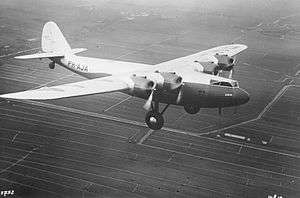Fokker F.XXXVI
The Fokker F.XXXVI[1] was a 1930s Dutch four-engined 32-passenger airliner designed and built by Fokker. It was the largest transport designed and built by Fokker.
| Fokker F.XXXVI | |
|---|---|
 | |
| Role | 32-passenger transport |
| Manufacturer | Fokker |
| First flight | 22 June 1934 |
| Introduction | 1935 |
| Retired | 1940 |
| Primary users | KLM Scottish Aviation |
| Number built | 1 |
Development
The Fokker F.XXXVI registered PH-AJA first flew on 22 June 1934 and was a high-wing cantilever monoplane with a fixed tailwheel landing gear. In Fokker tradition, the wing was an all wood structure and the fuselage was fabric covered steel tube. It was powered by four Wright Cyclone radial piston engines mounted in the wing leading edge, and carried 4 crew and 32 passengers in four eight-seat cabins. In an unusual decision, Fokker engineers went to great length in soundproofing the passenger cabin, enabling passenger to converse in a normal voice after take off.[2] It was delivered to KLM and operated on European routes from March 1935. Although it had a good payload its range was much less than and was structurally inferior to (the maintenance advantages of all-metal aircraft were becoming clear) the new Douglas DC-2 and DC-3 and only one was built. KLM sold the aircraft in 1939 to Scottish Aviation for use as a crew and navigation trainer for the Royal Air Forces No.12 Elementary Flying Training School, which was operated by Scottish Aviation. It was scrapped in 1940 after it burnt out in a take-off accident.
Airspeed Ltd. in Great Britain arranged a license to build F.XXXVIs for the British market as the Airspeed AS.20, but no orders were received.[3]
Operators
Specifications
.jpg)
Data from Jackson p. 373 and de Leeuw p.102
General characteristics
- Crew: 4
- Capacity: 32-passengers
- Length: 24.0 m (78 ft 8 in)
- Wingspan: 33.0 m (108 ft 2 in)
- Height: 8.3 m (27 ft 3 in)
- Wing area: 172 m2 (1,850 sq ft)
- Empty weight: 10,300 kg (22,700 lb)
- Gross weight: 16,500 kg (36,366 lb)
- Powerplant: 4 × Wright Cyclone SGR-1820-F2 radial piston engines , 560 kW (750 hp) each
Performance
- Cruise speed: 280 km/h (165 mph, 143 kn)
- Range: 1,536 km (960 mi, 830 nmi)
Related lists
References
- de Leeuw pp.100-3
- "The Fokker F.XXXVI" FLIGHT, 26 July 1934, photos with main article
- Taylor, H.A.. Airspeed Aircraft since 1931. Putnam. 1970. London. ISBN 0-370-00110-9
Bibliography
| Wikimedia Commons has media related to Fokker F.XXXVI. |
- R.de Leeuw, Fokker Commercial Aircraft. 1994, Fokker, The Hague
- A.J. Jackson, British Civil Aircraft since 1919 Volume 2, 1974, Putnam, London, ISBN 0-370-10010-7
- The Illustrated Encyclopedia of Aircraft (Part Work 1982-1985), 1985, Orbis Publishing, Page 1895/6
- Taylor, H.A.. Airspeed Aircraft since 1931. Putnam. 1970. London. ISBN 0-370-00110-9